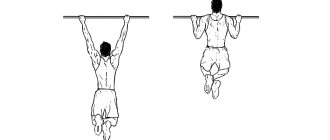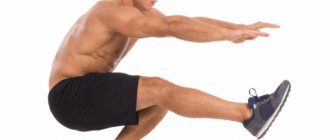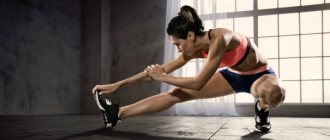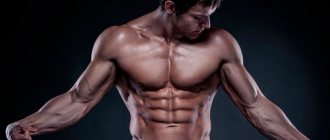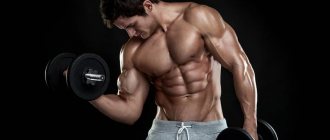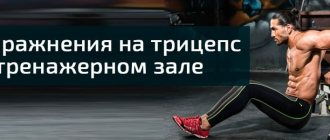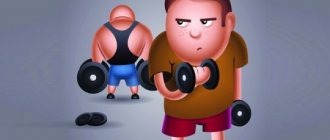One visit to your local gym and you feel like you're entering a matrix: lots of equipment and you're not sure you know how to use it. In this article we will look at what types of exercise equipment there are in the gym and how to exercise on them.
Below you will find reviews of the most popular sports equipment, their types, what they are intended for and how to use each of them for maximum results. All descriptions are accompanied by photos of the equipment itself, the muscle groups they work, and a video with the correct technique for performing the exercises.
We have compiled this equipment guide to provide detailed information about all types of fitness club equipment in one place and how to use them. This guide will help you create an effective exercise program.
Where to start working out in the gym?
I will tell you how to properly start working out in the gym and about the basic recommendations and rules for those who are just starting strength training. Whether you want to get stronger, lose weight, build muscle, or simply improve your fitness, this article will help you get on the right path to health and achieving your fitness goals.
Strength training will also provide remarkable results for those who have tried (and failed) to get in shape with just diet and cardio. Consistent and regular training (more than 2 times a week for 12 weeks) will lead to:
- Increased muscle fiber size
- Building strength
- Increasing tendon strength
- Increasing the strength of ligaments
All this will help you build a healthy and resilient body, and also reduce the risk of injury. You will end up looking absolutely amazing!
Gym for beginners: rules of conduct
- Always bring a towel with you to place on the machines and equipment you will be using.
- Return dumbbells, barbells, weight plates, and other equipment after use.
- Don't rest for long periods of time between sets when working on machines while others are waiting their turn.
- Finally, leave your cell phone in a locker or car so that others won't be forced to listen to your conversations.
Exercises for home training
Of course, to analyze all the existing exercises, one article is not enough. Therefore, we will select only the most popular ones. Also, in order not to write with what you can perform this or that movement, letters will be in brackets.
- C -
own weight - G - dumbbells (bottles)
- E - expander
- F
— weighted vest (backpack)
Neck
- Weighted Neck Curl (D)
- Neck extension with weights (D)
Shoulders
- Seated presses (D)
- Push-ups while standing on your hands (S, F)
- Standing raises (G, E)
- Raises arms in front of you (G, E)
- Swing to the side in a tilted position (G, E)
- Pull to the chin (G, E)
Breasts
- Bench press (on the floor or pouf) (D)
- Push-ups from the floor, with arms wide (S, F)
- Lateral spread (D)
- Pullover (G)
Back
- Pull-ups on the bar, narrow or wide grip (S, F, D)
- Bent-over row (G, E)
- Australian pull-ups (S, W)
- Shrugs (S, G)
Biceps
- Bending arms while standing or sitting (G, E)
- Biceps pull-ups (S, F)
- Hammer curls (G, E)
Triceps
- Push-ups from the floor, with a narrow position of the hands (S, F)
- Dips (S, F)
- Reverse push-ups (S, D, F)
- Extension of arms from behind the head (G, E)
- French press (G)
Press
- Hanging Leg Raise (C)
- Crunches lying on the floor (C, D)
Legs and buttocks
- Squats (Front, Classic, Sumo) (S, G, F, E)
- Lunges (S, G, F)
- Plie squats (G, F)
- Deadlift on straight legs (G, E)
- Walking to the side (E)
- Taking the leg back (E)
- Leg abduction to the side (G, E)
Caviar
- Standing calf raise (S, D, F)
- Seated calf raise (C, D)
Now we have everything we need. And it’s time to draw up a rough workout plan at home.
Common Newbie Mistakes
- Using too heavy weights in the early stages . Start with small loads and then gradually increase them. If your technique suffers, you sway or use inertia, then this means that you have chosen too much weight. In addition, it increases the risk of injury and reduces the effectiveness of working the target muscle groups.
- Using too light a weight . It always makes sense to play it safe, but if you can do 30 reps with a certain weight, then it's probably better to increase it. Tip: Increase weight by no more than 5% at a time.
- Doing repetitions too quickly . Lifting heavy weights at a slow, controlled pace puts more muscle tension and allows you to break down more muscle fibers and reduce the risk of injury. Remember that joints are only as strong as the muscles that surround them.
- Insufficient or excessive rest . Both factors have a negative impact on training. It is recommended to rest between sets for 30 to 90 seconds.
Benefits of exercise equipment for exercising at home
Exercise machines are excellent training equipment that can be used at home. Their main advantages include:
- you can purchase several options for different types of load;
- the ability to adjust the load gradually;
- many models are compact, which allows them to be placed in an apartment or country house without any problems;
- modern multifunctional displays allow you to analyze not only time, but also the number of calories, speed, mileage traveled and other indicators;
- Will class times not depend on seasonality? time of day or weather conditions.
The purchase of such sports equipment has a specific goal - to shape your figure, lose weight, develop your physical fitness, achieve high performance in sports, so the most important criterion will always be the effectiveness of the exercise. The choice will depend on the technique of performing the exercises, personal preferences and the desired result that is planned to be obtained. It is better to give preference to high-quality models from well-known brands, although they are more expensive than analogues from unknown manufacturers.
Training program for beginners
This set of exercises in the gym for beginners is perfect even for those who even come to work out in the gym for the first time. By exercising according to this scheme, you can strengthen your ligaments and joints, as well as prepare your muscles for more complex workouts and exercises.
- Running on a treadmill - 5-10 minutes
- Leg press - 1 set
- Lying leg curl - 1 set
- Pulldowns to the chest - 1 set
- Reduction of arms in the butterfly simulator - 1 approach
- Arm extension in crossover with rope - 1 approach
- Biceps curls in the simulator - 1 approach
- Overhead press in the simulator - 1 set
- Crunches in the simulator - 1 approach
- "Bicycle" - 1 approach
Note ! Beginners should not use heavy basic exercises in their first workouts. This approach can result in injuries and forever discourage you from working out in the gym.
Moreover, a smooth entry into the training regime will provide a better start, help avoid injuries and soreness, and make it possible to get results faster.
The most popular exercise machines
The simulator is a mechanical, electrical or combined apparatus that is capable of simulating various loads. All exercise equipment is divided into two large groups – cardio and strength.
The main task of strength training equipment is to tighten weak muscles and give the necessary load to those parts of the body that require correction. All strength training equipment can be divided into home, fitness class and professional. The most popular types of strength training devices are kettlebells, dumbbells, barbells and horizontal bars. It’s great if you have such projectiles in your apartment or yard
Cardio equipment has a positive effect on the physical condition of the body, develops muscles, and trains the cardiovascular system. Cardio training is beneficial for everyone, but you need to take into account the degree of stress depending on your level of training and the state of health of the body. The following cardio equipment are considered the most effective for weight loss:
- The treadmill is the most massive exercise machine that simulates not only running, but also walking. Gives optimal load for feet and knees. It puts stress on the hip joints, and due to significant sweating, unnecessary toxins are removed from the body. Cushioning is able to absorb the full force of the impact that occurs during running, which reduces the load on the back. Due to its dimensions, it is suitable for fitness clubs, as well as large apartments.
- An orbitrek or elliptical trainer is in great demand for home workouts. The foot moves along an oval path during movement. The main load will be on the hips; a convenient handrail prevents the spine from overworking.
- Exercise bike - imitates cycling, is gentle on joints, and the foot does not hit the surface, so this exercise will be better if you have back problems. Most of the load falls back on the hips.
- Steppers are inexpensive and compact equipment; they imitate a person climbing stairs. The load is placed on the front of the thigh and quadriceps, while it is minimal compared to other types.
There is also a manual ergometer, which allows you to pedal directly with your hands, and rowing machines, which are able to use the upper legs and body, simulating rowing. Orbitracks, treadmills and exercise bikes are considered the most popular and popular for home use.
Training Guidelines for Beginners
This program is designed to improve the physical fitness of a healthy adult who has never exercised before (or has little experience).
You will notice that most of the exercises are performed in machines. This is intentional because beginners have less stability in their joints and weaker core muscles. When trying to immediately work with free weights (dumbbells or barbells), beginners increase the risk of injury.
Using machines provides support to these weak areas and allows you to isolate and strengthen the muscles before moving on to free weights.
- Perform the workout at least 2 times a week to ensure significant strength gains.
- Between each workout there should be 1 day of rest.
- At least 1 set of 8-12 repetitions should significantly fatigue the muscles. That is, you should choose a weight with which you will not be able to perform 2 sets in a row without a 30-90 second rest break.
- Performing one full range of motion repetition in a slow and controlled manner should take 4-5 seconds.
- Rest at least 30 and no more than 90 seconds between sets, and 1 to 2 minutes between exercises.
Benefits and contraindications of exercises
Working out on a home cardio machine is not only aerobic exercise for muscles and strengthening them.
Step exercises also allow:
- reduce weight;
- improve coordination of movements;
- activate the work of the heart, lungs, and brain;
- train the lungs and improve blood supply to the muscles of the limbs, abdominal cavity and pelvis;
- develop general body endurance;
- strengthen blood vessels and normalize blood pressure;
- increase the power and strength indicators of the body;
- reduce the amount of body fat.
6 more facts about the benefits of the stepper here
Scientists have proven: after three months of exercise, lung volume increases by 8.6%, waist circumference becomes smaller by 2%, and cholesterol levels decrease by 3.9%.
However, there are restrictions and contraindications for practicing on a stepper.
You should stop taking classes if you:
- injuries have not yet been completely cured (dislocations, fractures, sprains, etc.) or you suffer from serious diseases of the joints and spine;
- suffered a heart attack or stroke;
- have chronic diseases of internal organs - kidneys, liver, lungs (asthma);
- are in the last stages of pregnancy;
- suffer from arterial hypertension or diabetes mellitus in the acute stage;
- being treated for colds with high fever.
Important! People who are significantly overweight and older people who love a healthy lifestyle should consult a doctor before starting exercise.
Tips for Newbies to the Gym
Here are some tips to help you get more out of your training:
- Stay hydrated! Be sure to drink at least 8-10 glasses of water per day. Dehydration can weaken you and reduce the effectiveness of your workouts. Also drink plenty of water during your workouts.
- Eat a small meal with equal parts lean protein (lean chicken, turkey, beef or fish) and complex carbohydrates (oatmeal, rice) 30-60 minutes before and 60 minutes after exercise. This will give the body energy and ensure its recovery.
- Do cardio (for fat burning) only after strength training or at other times of the day.
- Keep a training diary. Record the number of sets and repetitions, the size of the working weights, and the exercises performed. This will allow you to track your progress and progress.
- On your journey to building your body, take regular photos and measurements of all parts of your body to monitor your results.
Source:
https://www.bodybuilding.com/content/best-beginner-weight-training-guide-with-easy-to-follow-workout.html
Exercises that should always be done at the beginning of a workout[edit | edit code]
The weightlifting movements (snatch and clean and jerk) and their variations should always be done before any other exercises.
These exercises, which involve a large number of muscle groups, are technically complex and require a lot from the central nervous system, should always be performed first in any program. I thought this went without saying, but I've seen programs designed for professional athletes that put snatches after deadlifts, squats, bench presses, and bent-over rows!
Remember: if you include a weightlifting exercise in your program, always do it first. If there are two or more, then do the more technically difficult ones first: snatches should come before cleans, which in turn should come before pushes.

